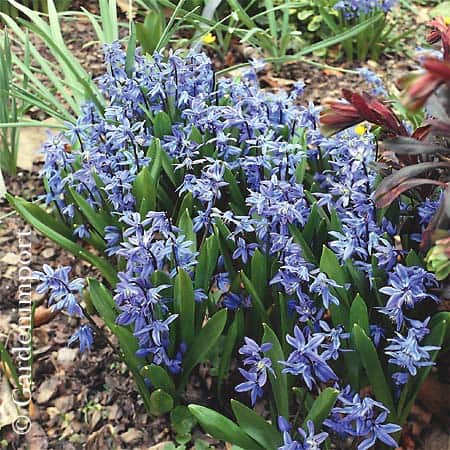
I have unreasonable expectations about spring bulbs: I want to plant them just once and have them return every spring, forever. That’s a bit of wishful thinking, and I’d do better to focus on bulbs with reasonable, though not unlimited, longevity. I’d just like them to return for several seasons, with normal flower size and a consistent number of blooms. One way to encourage a good showing next year is to fertilize after flowering to ripen the foliage, but some spring bulbs are capable of flowering for several years with little help from me.
The first that comes to mind is ‘Spring Beauty’ Siberian squill (Scilla siberica ‘Spring Beauty’, Zone 3). This is a hybrid of the common Siberian squill that spreads so readily through beds and into the lawn. ‘Spring Beauty’ is taller (eight inches / 20 cm), but with the same vivid blue colour of its smaller cousin; it makes a prominent display when a dozen bulbs are planted together. Hybridizing has eliminated the reproductive potential of ‘Spring Beauty’; it won’t spread, but my original bulbs have been coming back for a decade, and I look forward to them every spring.
Another long-lasting bulb is common camassia (Camassia quamash, Zone 4), sometimes called Indian hyacinth. It blooms in late spring with pretty blue flowers on 24-inch (60-cm) stems and thin reed-like green foliage. They’ve been flowering for more than 10 springs in my garden. There are several cultivars available, and one is ‘Melody’, with lavender-blue star-shaped flowers. Just a few look lovely among yellow tulips or daffodils.
A third candidate for long-time satisfaction is ‘Purple Sensation’ allium (Allium hollandicum ‘Purple Sensation’, Zone 4). Each 24-inch (60-cm) stem carries a domed electric purple flower that glows in the garden. These can be planted in groups, and also look well interspersed among emerging hostas and bleeding-hearts. I’ve had other ornamental alliums, too, and all seem capable of returning for several years.
And then there are returning — almost perennial — tulips. But that’s another story.








